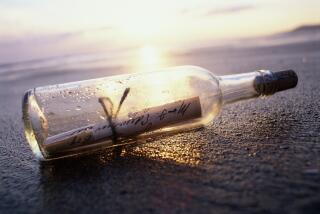Francis Crick’s newfound letters add to the drama of the DNA story
The drama that surrounded Francis Crick and James Watson’s 1953 unveiling of the structure of DNA is no secret — Watson described the heated competition between two British research groups in his bestselling book, “The Double Helix.” But part of the record had been thought lost when Crick’s papers were apparently thrown out by what he described as “an over-efficient secretary.”
That nameless secretary has now been exonerated. Researchers at Cold Spring Harbor Laboratory in New York recently uncovered the long-lost letters mixed up with the papers of Sydney Brenner, Crick’s officemate of more than two decades.
The letters — including some addressed to Crick and carbon copies of those he sent to others — reveal moments in which the discovery of the double helix might have taken a very different turn.
Watson and Crick were working at the Cavendish Laboratory at Cambridge University, then directed by William Lawrence Bragg. Meanwhile, Maurice Wilkins and Rosalind Franklin were working at King’s College London under John Randall. The two labs were both trying to uncover the structure of DNA, the molecule that contains the genetic code.
Bragg and Randall had worked out a gentlemen’s agreement, said Crick biographer Matt Ridley: Watson and Crick would focus on how genetic information was contained in proteins, while Wilkins and Franklin would study the entire DNA molecule. But the pair in Cambridge went ahead and worked on a physical model of the molecule, since Watson believed that was the best way to solve the problem.
Imagine, then, the outrage when Watson and Crick unveiled their model, which was based in part on data Watson heard Franklin present at a colloquium. Unfortunately for Watson and Crick, Watson had misheard what Franklin had said. She shot down their model in short order.
The entire episode generated more bad blood between the labs. Wilkins typed up a formal letter to Crick recommending that he stop working on the DNA problem. But the same day, Wilkins also hand-wrote a more personal letter:
“Dear Francis, This is just to say how bloody browned off I am entirely & how rotten I feel about it all & how entirely friendly I am. … We are really between forces which may grind all of us into little pieces.”
Crick and Watson’s reply was telling. “Cheer up and take it from us that even if we kicked you in the pants it was between friends,” they wrote. “We hope our burglary will at least produce a united front in your group!”
All three letters were part of the trove discovered this year in New York.
“Shakespeare would have gotten a good play out of this,” said Jan Witkowski, a professor at Cold Spring Harbor Laboratory who found the Crick letters along with colleague Alexander Gann.
In another Bard-like turn, the letters also show that history could have turned out very differently if the characters had a little more information on hand.
Watson and Crick ultimately proved their helical structure using one of Franklin’s crystallography photos. But some of her other photos didn’t seem to show a helix, and they could have derailed Watson and Crick early in the game.
“I must say I am glad I didn’t see it earlier, as it would have worried me considerably,” Crick confessed to Wilkins in a letter.
Indeed, the letters are most revealing when it comes to the relationship between Crick and Wilkins, said Robert Olby, a historian who has written extensively on the time period, including “Francis Crick: Hunter of Life’s Secrets.”
“What does come out is the strength of Crick’s friendship with Wilkins that somehow survives all these knocks,” he said.
The letters also reveal that Crick had been working on a textbook proposal in 1954 — a fact unknown to Watson at the time. Had Watson realized, it may have kept him from writing his own text, “Molecular Biology of the Gene.”







